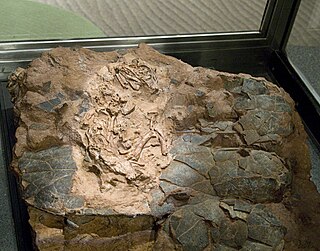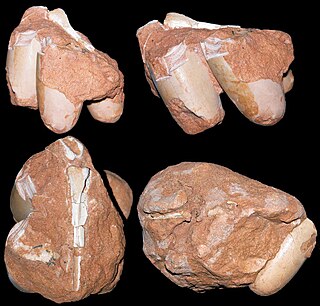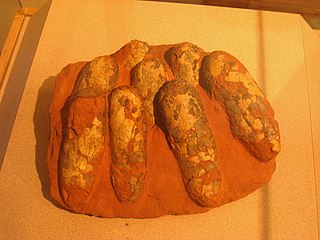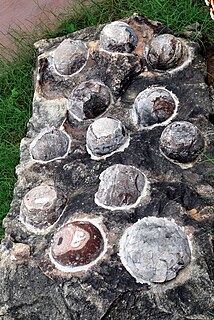
Macroelongatoolithus is an oogenus of large, fossil theropod eggs. They are known from Asia and from North America.

Macroolithus is an oogenus of dinosaur egg belonging to the oofamily Elongatoolithidae. The type oospecies, M. rugustus, was originally described under the now-defunct oogenus name Oolithes. Three other oospecies are known: M. yaotunensis, M. mutabilis, and M. lashuyuanensis. They are relatively large, elongated eggs with a two-layered eggshell. Their nests consist of large, concentric rings of paired eggs. There is evidence of blue-green pigmentation in its shell, which may have helped camouflage the nests.
Phaceloolithus is an oogenus of dinosaur egg found in the Dongting basin of the Hunan Province of China. The eggs have a subspherical shape, measuring up to 168 mm on the long axis, and having a very thin shell.
Continuoolithus is an oogenus of dinosaur egg found in the late Campanian of Alberta and Montana. It was laid by an unknown type of theropod. These small eggs are similar to the eggs of oviraptorid dinosaurs, but have a distinctive type of ornamentation.
Ageroolithus is an oogenus of dinosaur egg. It may have been laid by a theropod.
Dispersituberoolithus is an oogenus of fossil egg, which may have been laid by a bird or non-avian theropod.
Sankofa is an oogenus of prismatoolithid egg. They are fairly small, smooth-shelled, and asymmetrical. Sankofa may represent the fossilized eggs of a transitional species between non-avian theropods and birds.
Paraelongatoolithus is a late Cretaceous oogenus of Chinese fossil egg, classified in the oofamily Elongatoolithidae, which represents the eggs of oviraptorosaurs.

Egg paleopathology is the study of evidence for illness, injury, and deformity in fossilized eggs. A variety of pathological conditions afflicting eggs have been documented in the fossil record. Examples include eggshell of abnormal thickness and fossil eggs with multiple layers of eggshell. The identification of egg paleopathologies is complicated by the fact that even healthy eggs can be modified during or after fossilization. Paleontologists can use techniques like cathodoluminescence or thin sectioning to identify true paleopathologies in fossil eggs. Despite the diversity of paleopathologies known from fossil eggs, the vast majority of conditions known to afflict modern eggs have not yet been seen among fossils.
Coralloidoolithus is an oogenus of dinosaur egg from the Tiantai Basin in Zhejiang Province, containing a single known oospecies C. shizuiwanensis. Formerly, it was classified in the oogenus Paraspheroolithus; however, it was considered sufficiently different to be classified in its own genus. C. shizuiwanensis is similar to Stalicoolithus, leading to their classification in the same family, Stalicoolithidae.
Paradictyoolithus is an oogenus of dictyoolithid dinosaur egg from the Zhejiang Province, China. They are nearly spherical eggs, measuring up to 13.9 cm (5.5 in) in diameter, and have a thin eggshell. Their shells are made up of three or four superimposed layers of eggshell units. The two known oospecies are distinguished mainly by their pore structure.

Styloolithus is an oogenus of highly distinctive fossil egg from the Upper Cretaceous Djadokhta Formation and the Barun Goyot Formation in Mongolia.

Elongatoolithidae is an oofamily of fossil eggs, representing the eggs of oviraptorosaurs. They are known for their highly elongated shape. Elongatoolithids have been found in Europe, Asia, and both North and South America.
Guegoolithus is an oogenus of fossil egg from the Barremian of Spain. It is classified in the oofamily Spheroolithidae, and was probably laid by an ornithopod dinosaur.
Dictyoolithidae is an oofamily of dinosaur eggs which have a distinctive reticulate organization of their eggshell units. They are so far known only from Cretaceous formations in China.

Gobioolithus is an oogenus of fossil bird egg native to Mongolia. They are small, smooth-shelled, and elongated eggs that were first discovered in the 1960s and early 70s during a series of fossil-hunting expeditions in the Gobi desert. Two oospecies have been described: Gobioolithus minor and G. major. The eggs were probably laid in colonial nesting sites on the banks of rivers and lakes.
Pachycorioolithus is an oogenus of small, thin-shelled fossil egg from the early Cretaceous in China. It probably belongs to a bird, though there is a possibility the parent was a non-avian theropod. It was named in 2016, based on a single specimen found in Zhejiang.
Plagioolithus is an oogenus of fossil egg. It is from the Early Cretaceous of Japan. It was probably laid by a bird, making it the oldest known fossil bird egg.









